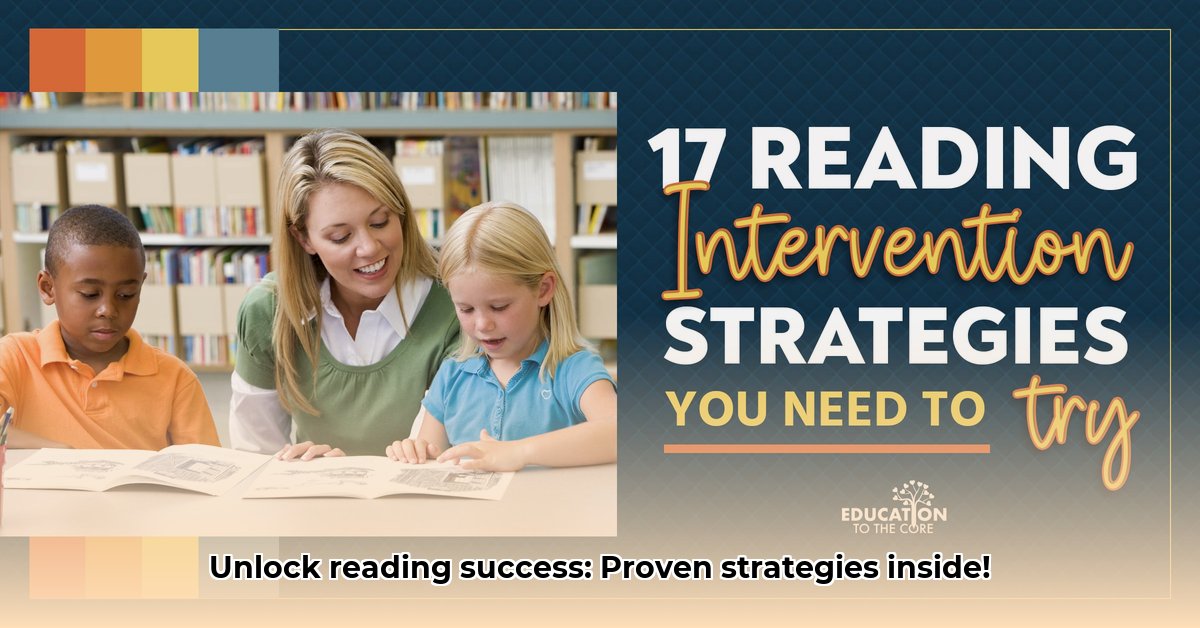
Helping students succeed in reading is a rewarding yet challenging endeavor. Many students struggle, impacting their academic performance and self-esteem. This guide provides educators with practical, research-backed strategies to foster reading proficiency in every child. For a deeper dive into reading foundations, check out this helpful resource: Reading Foundations.
Understanding Reading Difficulties
Why do some students struggle with reading? It's rarely a single factor. Challenges might stem from difficulties with phonics (decoding words), fluency (reading smoothly and expressively), vocabulary (understanding word meanings), or comprehension (grasping text meaning). Underlying learning differences or emotional factors can also play significant roles. Early identification and intervention are crucial for optimal outcomes. Don't we all want to see every child blossom?
Building a Solid Foundation: Essential Reading Skills
Effective reading instruction requires a strong foundation. Three key areas need targeted support:
Phonics Power: Decoding the Code
Phonics instruction connects letters and sounds. It's the "secret code" to unlocking written language. Consistent, explicit phonics instruction is vital for accurate word decoding.
Fluency: Reading with Rhythm and Expression
Fluent reading goes beyond accuracy; it involves reading smoothly, quickly, and expressively. Techniques like repeated reading and paired reading significantly improve fluency. How can we encourage a love of the flow of language?
Vocabulary Building: Expanding Word Knowledge
A rich vocabulary is vital for comprehension. Direct vocabulary instruction, encouraging students to use context clues, and creating a language-rich classroom environment significantly enhance word knowledge. Do you use varied techniques to engage learners with new vocabulary?
Comprehension: Making Meaning from Text
Once students decode words accurately and fluently, comprehension—understanding the text—becomes the focus. Several strategies enhance comprehension skills:
- Monitoring Comprehension: Teach students to self-check their understanding while reading ("Does this make sense?").
- Asking Questions: Encourage students to ask questions, fostering deep engagement with the text.
- Visualizing: Encourage students to create mental images of scenes, characters, and events.
- Making Connections: Help students connect the text to their own experiences and prior knowledge.
Techniques such as think-alouds (verbalizing thought processes during reading) and graphic organizers (visual tools for organizing ideas) also greatly support comprehension. Reciprocal teaching, where students lead discussions, is another powerful method.
Differentiated Instruction: Meeting Individual Needs
Every student is unique. Differentiated instruction tailors teaching to individual needs. This might involve using diverse materials, adjusting pacing, or providing multiple ways to demonstrate understanding. It's about creating personalized learning plans for each student. What are some innovative ways you differentiate your reading instruction?
Assessment and Monitoring: Tracking Progress
Regular assessment is vital to monitor the effectiveness of your interventions.
- Formative Assessments: Ongoing checks (quick quizzes, observations) guide instruction, showing what works and what needs adjustment.
- Summative Assessments: Comprehensive evaluations measure overall progress and inform future planning.
Data from assessments allows for refinement and celebration of successes. How often do you assess progress, and how do you use the data?
Collaboration: Teamwork for Success
Effective reading intervention is a collaborative effort. Partnerships with parents and specialists (reading specialists, special education teachers) strengthen support for students. Open communication ensures a united front for student success – a team effort for every learner.
Actionable Steps for Effective Reading Intervention
Here’s a practical plan for implementation:
| Step | Action | Why It's Important | Resources |
|---|---|---|---|
| 1 | Assess each student's reading skills. | Identify specific areas needing support. | Standardized tests, informal reading inventories |
| 2 | Develop individualized learning plans (ILPs). | Tailor interventions to meet individual needs and learning styles. | Templates, curriculum materials, teacher expertise |
| 3 | Employ evidence-based reading intervention strategies. | Use strategies proven effective through research. | Professional development, research-based articles |
| 4 | Regularly monitor progress using formative and summative assessments. | Track student growth and adjust interventions as needed. Celebrate successes! | Progress monitoring tools, data analysis, classroom observations |
| 5 | Collaborate with parents, specialists, and colleagues. | Foster a supportive network to maximize each student's success. | Communication platforms, meetings, shared resources |
Remember, patience and encouragement are essential. Celebrate every milestone, no matter how small. With dedication and the right strategies, you can empower every child to become a confident, capable reader. Continuous learning and adapting to the latest research are crucial for maximizing your impact.
Choosing the Right Reading Intervention Program for Diverse Learners
Selecting the best program requires a multifaceted approach.
Understanding Learners' Needs
Accurate assessment is crucial. What are the specific challenges? Do students have dyslexia or other learning differences? A thorough evaluation guides program selection.
Research-Based Methodologies
Choose programs grounded in evidence-based practices, such as explicit, systematic, and multi-sensory instruction (often incorporating Orton-Gillingham elements). Scrutinize the program's research support.
Program Selection: Aligning with Needs and Resources
Consider alignment with students’ learning styles and resource availability. Will the program fit within your school's resources and structure?
Implementation and Monitoring
High-quality teacher training and ongoing monitoring are vital for success. Consistent monitoring allows for adjustments and ensures program effectiveness.
Collaboration
Effective intervention is a team effort. Collaboration with parents, administrators, and specialists creates a supportive learning environment.
Choosing the right intervention program is a process of thoughtful consideration, balancing student needs, research, and practical implementation. There is no one-size-fits-all solution; the best program adapts to your students' unique needs.